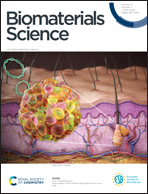Ultra-efficient delivery of CRISPR/Cas9 using ionic liquid conjugated polymers for genome editing-based tumor therapy†
Abstract
Emerging CRISPR-Cas9 systems can rebuild DNA sequences in the genome in a spatiotemporal manner, offering a magic tool for biological research, drug discovery, and gene therapy. However, low delivery efficiency remains a major roadblock hampering the wide application of CRISPR-Cas9 gene editing talent. Herein, ionic liquid-conjugated polymers (IL-CPs) are explored as efficient platforms for CRISPR-Cas9 plasmid delivery and in vivo genome editing-based tumor therapy. Via molecular screening of IL-CPs, IL-CPs integrated with fluorination monomers (PBF) can encapsulate plasmids into hybrid nanoparticles and achieve over 90% delivery efficiency in various cells regardless of serum interference. In vitro and in vivo experiments demonstrate that PBF can mediate Cas9/PLK1 plasmids for intracellular delivery and therapeutic genome editing in tumor, achieving efficient tumor suppression. This work provides a new tool for safe and efficient CRISPR-Cas9 delivery and therapeutic genome editing, thus opening a new avenue for the development of ionic liquid polymeric vectors for genome editing and therapy.



 Please wait while we load your content...
Please wait while we load your content...